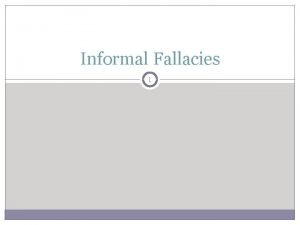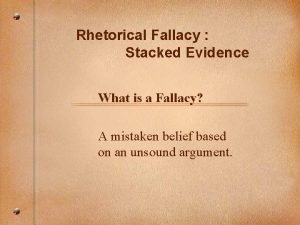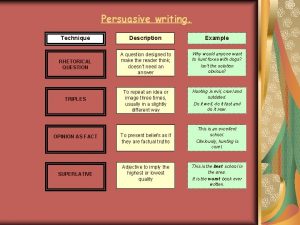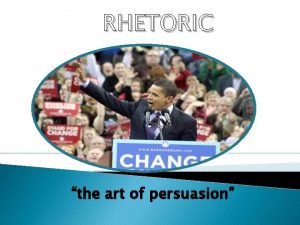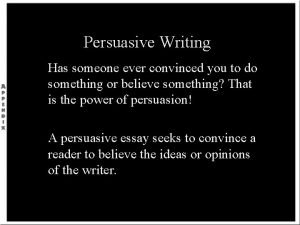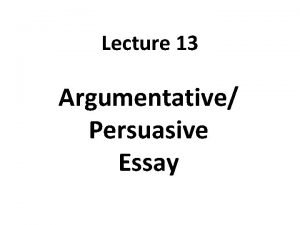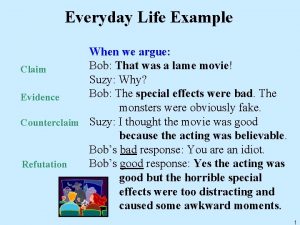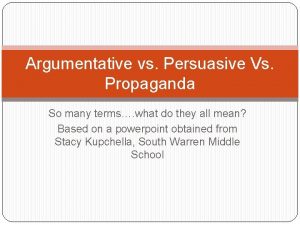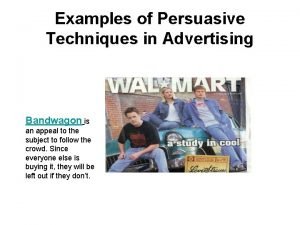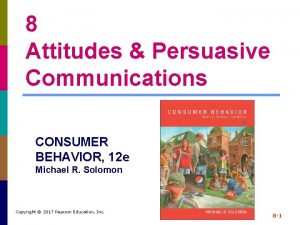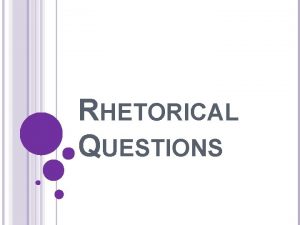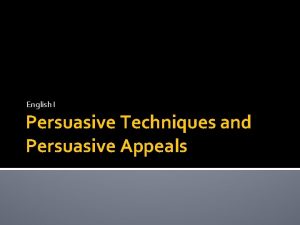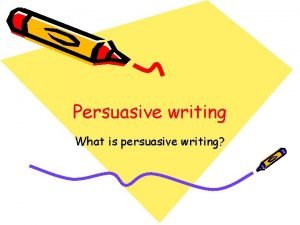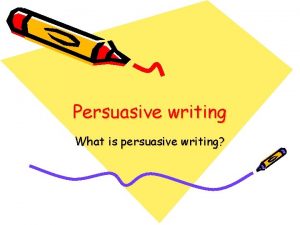Persuasive Argument Rhetorical Argument and Fallacy What is





























- Slides: 29

Persuasive Argument Rhetorical Argument and Fallacy

What is “rhetoric”? • ‘Rhetoric’ is the word we use to describe how writers use words to communicate: Ideas Stories Emotions In other words, writers use rhetorical devices to MANIPULATE readers. Good writers know how to anticipate and control what you think (or might think) using these techniques.

What is an argument? • Argument does not mean fighting. It means to have a reasoned debate. • Good arguments are arguments that “clash”. When arguments “clash, ” that means the parties who debate respond to each other’s points instead of their preplanned speeches. • Debate through argument is one way we deepen our understanding of various issues.

Rhetorical Techniques Persuasive writers want to convince their readers. This is called “argument”—but not the fighting kind. Writers are trying to prove something or make a point. The three primary techniques they use, from strongest to weakest are: • Logos • Ethos • Pathos

Logos • When writers use “logos, ” they appeal to our sense of logic. • Arguments that appeal to logic—logos— are reasonable and reveal clear causes and effects. • “Common sense” is not the same as logic!

Syllogisms • The most common form of logic is known as a syllogism. This is an argument with two premises and a conclusion. • A premise is an assumption on which a conclusion is based. If both premises are true, then the conclusion must be true.

• All dalmatians are dogs • Spot is a dalmatian • Therefore Spot is a dog

• All coaches are certified teachers • Mr. Johnson is a coach • Therefore Mr. Johnson is a certified teacher • This simple form of logic is known as a syllogism • Each statement is known as a premise that the conclusion is based on.

• We need to use logic in our essays which no one can disagree with • This, however, assumes that your premises are true • All left handed people are smart • Josephine is left handed • Therefore Josephine is smart

Everyday Logic • Eat your food. It is good for you • If you don’t eat your food, you will get sick • Brush your teeth after every meal • If you do not brush your teeth after your meals, your teeth will decay

Ethos • Ethos arguments appeal to your sense of ethics—what you think is right and wrong. • Ethos arguments are OK if the values or morals are shared between those arguing. If they aren’t, then the argument will not make sense to one of the parties. • In ethos arguments, you will see moralitydriven words like “should, ” “must, ” “imperative, ” “right, ” and “wrong”.

• Ethos arguments also appeal to authority. A quote from an expert in a particular field to support your argument could be considered an appeal to ethos.

• Ethos is used a lot in TV commercials • Michael Jordan wears Hanes underwear • Therefore Hanes underwear is a good quality product

Pathos • Pathos arguments appeal to your emotions. • Just because an issue makes you feel a certain way doesn’t mean the argument is logical (or illogical). • Pathos is used when a sense of empathy is required to convince somebody.

• Children use this when they want to convince their parents about something • People will laugh at me, if I still use this old cell phone

• George Bush and the decision to invade Iraq. • If we do not attack Al Quaeda in Iraq, they will launch an attack deadlier than the attack of 9/11 • Saddam Hussein has weapons of mass destruction and we must destroy them before he uses them on us or our allies

Fallacies • A “fallacy” is an error in argument. • A “fallacy” is illogical, even though it may seem right or sound good. • A “fallacy” weakens an argument. • If you can identify a fallacy, you can defeat the argument. • Good persuasive writers find fallacies in their opponents’ arguments.

• In order to understand what a fallacy is, one must understand what an argument is. Very briefly, an argument consists of one or more premises and one conclusion. A premise is a statement that is offered in support of a claim being made. The claim can be regarded as the conclusion of an argument.

• A fallacy is, very generally, an error in reasoning. This differs from a factual error, which is simply being wrong about the facts. A fallacy is an "argument" in which the premises given for the conclusion do not provide the needed degree of support.

List of Common Fallacies • • Ad Hominem Argument from Authority Red Herring Slippery Slope Straw Man False Dilemma False Cause Bandwagon Fallacy

Ad hominem fallacy • Ad hominem really means “at the man. ” • Ad hominem is a fallacy because it discredits or insults the person giving the argument while ignoring the argument. • Person A: “The sky is blue. ” • Person B: “That has to be false because person A is an idiot. ” • Person B made an ad hominem error.

Argument from authority fallacy • Argument from authority means that an argument is deemed true because someone important—famous or credentialed—believes it. • Person A: “These magnets have a special healing power because Dr. Truegood went on TV saying they really work. ” • Person A has made an error because someone’s opinion—doctor or otherwise—does not make something true.

Bandwagon • The Bandwagon is a fallacy in which a threat of rejection by one's peers (or peer pressure) is substituted for evidence in an "argument. “ • Comes from the phrase, “jump on the bandwagon” • Vote for Brent and Vanessa because everyone is voting for them.

Red herring fallacy • Red herring is a distraction that ignores the main argument. • Person A: “Don’t talk during class. ” • Person B: “Well he was talking. Why don’t you go talk to him? • Person B is using a red herring to attempt to distract person A.

Slippery slope fallacy • The slippery slope fallacy falsely assumes that if the effect of the argument does one thing, that it will only do more. • Slippery slope uses our fear that things will get worse. • Person A: “We can’t allow cops to shoot their guns because if they start shooting criminals, eventually they will start shooting people whenever they want. • This false statement shows that not everything gets continually worse.

Straw man fallacy • Straw man fallacies misrepresent the argument of the other side in order to defeat it: • Person A: “The best way to combat AIDS is to make condoms easily available”. • Person B: “Why do you want to encourage teenagers to sleep around? ” • Person B has misrepresented Person A’s position and has made it easy to defeat.

False dilemma fallacy • False dilemma is a fallacy that presents two options as if they’re the only two available. • Often there are many more options available, when one thinks critically. • “If you’re not on my side, you’re my enemy!” This is the classic false dilemma. You can be on his/her side on some issues but not on others. • In false dilemma—and many of these fallacies— the arguer is trying to control the terms of the argument. Never let the other party create or define the rules.

Spurious correlation/False Cause fallacy • Spurious correlation/ad hoc is a fallacy where A event occurs, then B event occurs. • The arguer then makes a false cause connection. • I ate an apple. Then I got hit by a car. Eating apples causes one to get hit by cars. • This is easy to identify in the example above, but what about this one: I ate an apple every day for 20 years. I never got cancer. Eating apples keeps cancer away. Fallacy? Yes.

Find the Fallacy Clear the shelves Regarding the article, "T-shirt latest casualty of crusade, " (June 23), a popular T-shirt that displayed the word "Fontijuana" was removed from a Walgreens store after Fontana Mayor Mark Nuaimi decided we the consumers had no right to buy or wear it. There are many other items that some might object to being sold at that store. Some examples include certain types of birth control, greeting cards with religious statements, etc. Why not just take everything off the shelves? MARIE FISHER, Fontana, Sunday, July 2, 2006
 Fallacy of division examples
Fallacy of division examples What is a rhetorical fallacy
What is a rhetorical fallacy Rhetorical questions in persuasive writing
Rhetorical questions in persuasive writing Logos definition literature
Logos definition literature Concept of logical reasoning
Concept of logical reasoning Rhetorical analysis vs synthesis essay
Rhetorical analysis vs synthesis essay Rhetorical devices in atticus closing argument
Rhetorical devices in atticus closing argument Ontological argument
Ontological argument Macbeth comprehension answers
Macbeth comprehension answers The moon glowed like simile
The moon glowed like simile Settings in dr jekyll and mr hyde
Settings in dr jekyll and mr hyde Logical fallacies and rhetorical devices
Logical fallacies and rhetorical devices Learning to read and write frederick douglass audience
Learning to read and write frederick douglass audience Compare and contrast rhetorical analysis
Compare and contrast rhetorical analysis Compare and contrast rhetorical analysis essay example
Compare and contrast rhetorical analysis essay example Genre and rhetorical situation
Genre and rhetorical situation Richard buttny
Richard buttny Cause and effect rhetorical strategy
Cause and effect rhetorical strategy Demonstrative speeches
Demonstrative speeches Rhetoric: the art of persuasive writing and public speaking
Rhetoric: the art of persuasive writing and public speaking Writing to convince
Writing to convince Elaboration techniques examples
Elaboration techniques examples Persuasive essay vs argumentative
Persuasive essay vs argumentative Conclusion paragraph
Conclusion paragraph Informative and persuasive venn diagram
Informative and persuasive venn diagram Define a business letter
Define a business letter Persuasive vs argumentative
Persuasive vs argumentative Stir up sympathy persuasive statement
Stir up sympathy persuasive statement Persuasive techniques in advertising examples
Persuasive techniques in advertising examples Attitudes and persuasive communications
Attitudes and persuasive communications
